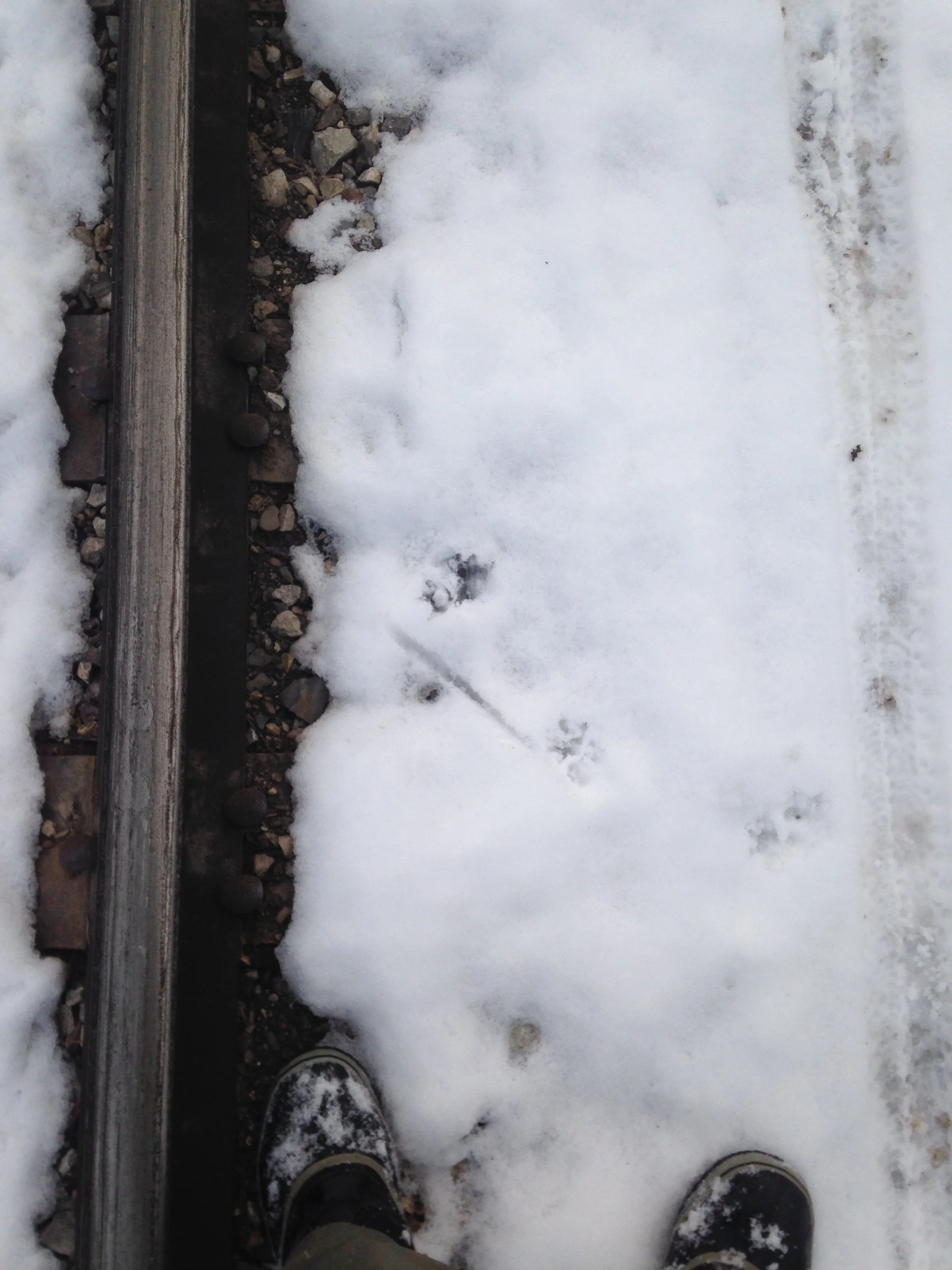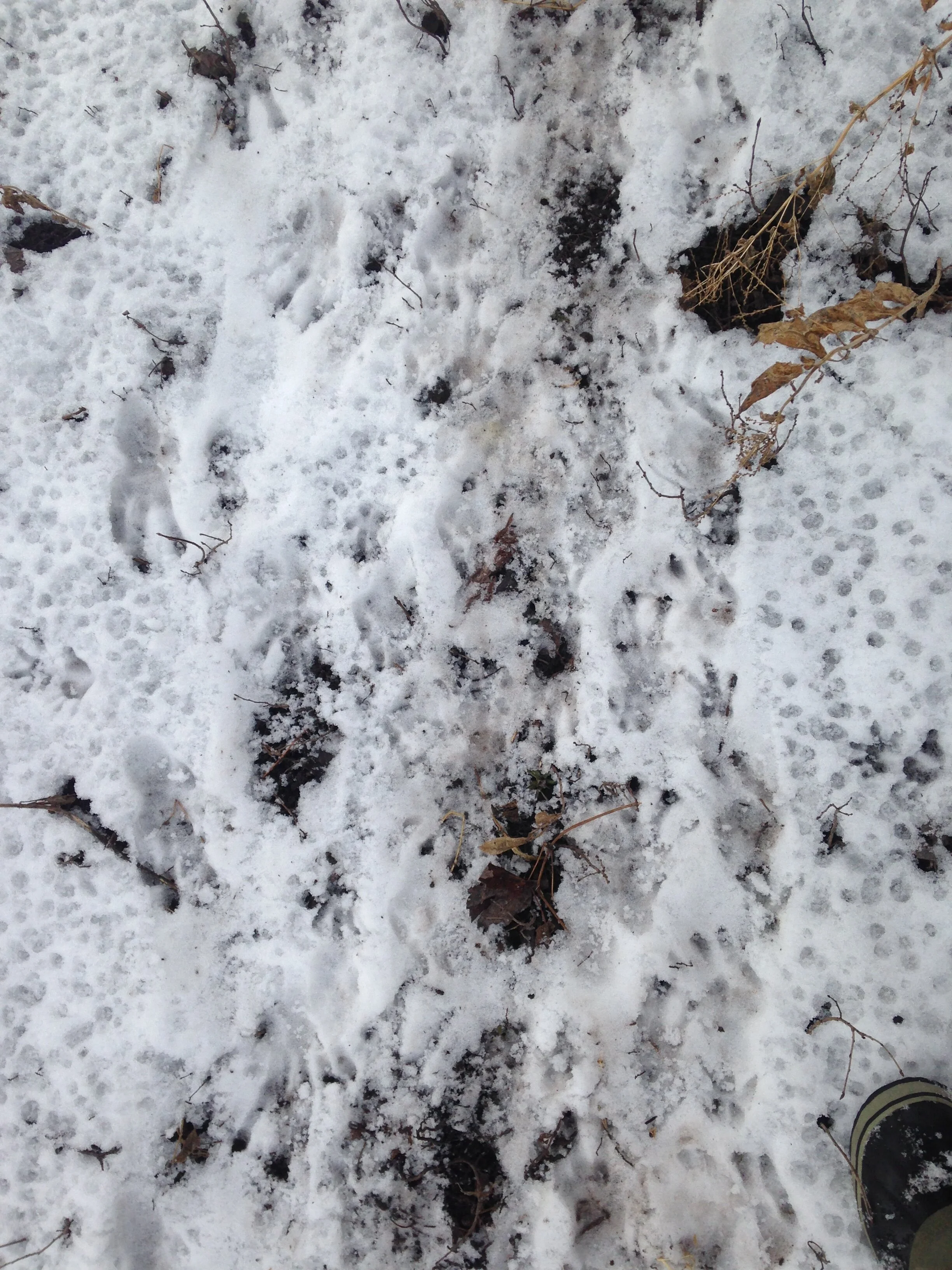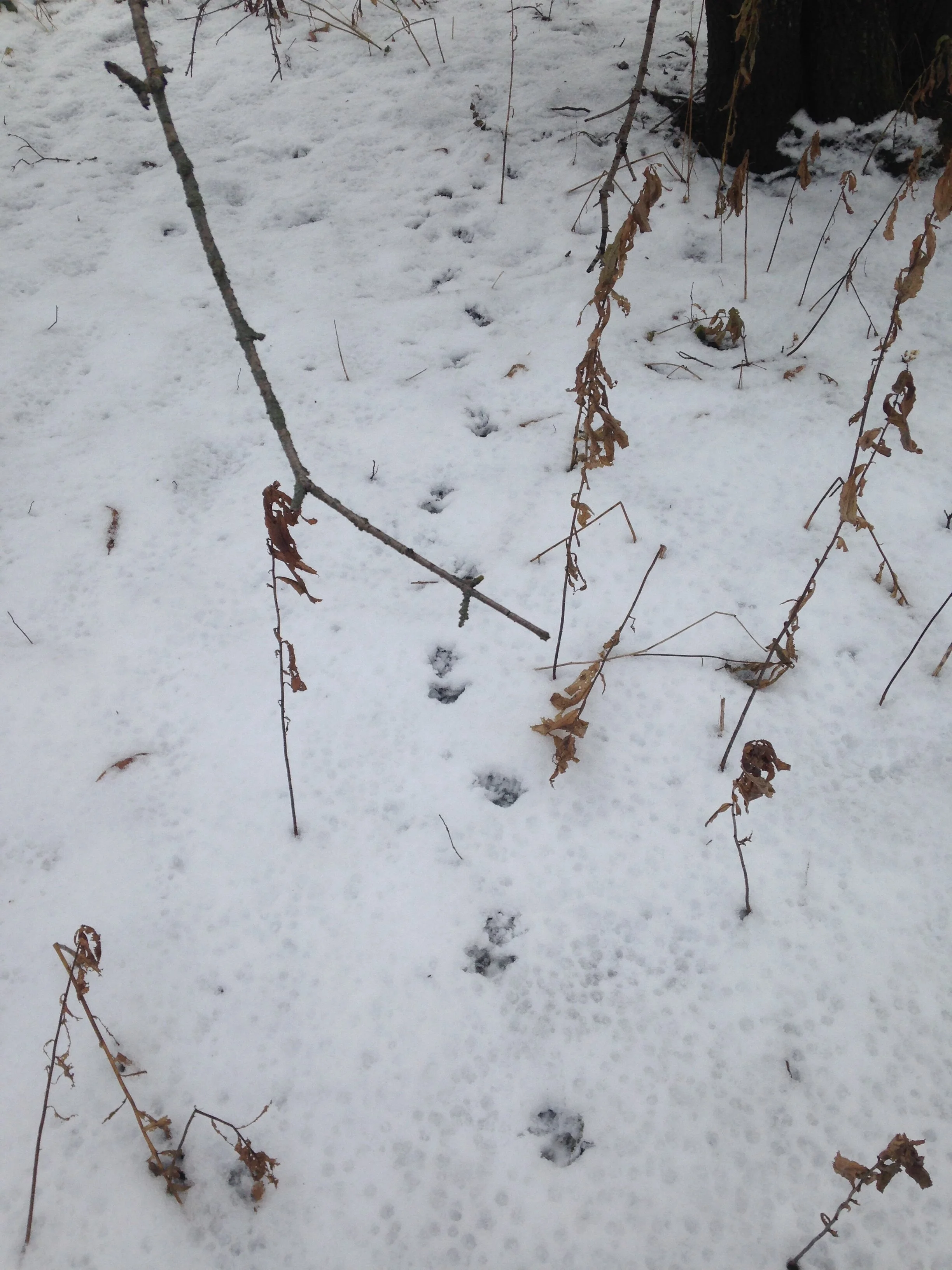Tracking journal for December 5, 2020. Along Eramosa River.
I tried to get up as if I were going to work. Same morning routine as well so I didn’t get distracted in trying to make any new decisions. I ended up leaving the house at 7:05am or so, 5 minutes later than I would have if I were really going to work, but this was a day off so it’s ok to give myself some lenience.
I took the normal trail I usually take, but when I came to the Northward split I decided I would take it, just to see if anything new stuck out for me along the way. And, of course something did.
I stepped on the first few Opossum (Didelphis virginiana) tracks before I even saw them, but I luckily did look down with enough time that I didn’t crush the whole trail. There were two small handsy looking tracks, with one overlapping the other. A little ways in front of me, there was another set, and then up ahead of them, another set again. The snow was just crusty enough from thawing a little bit the day before and then freezing overnight that these tracks were stable enough to guess that I may be able to follow this trail for a while.
Notes drawn from tracking journal.
I measured what I believed, and later confirmed, to be the hind tracks as they were coming in clearer, and catching my eye a little bit more than the fore tracks. The hinds were about 47 mm L x 58 mm W. They were so distinct with the toe 1, the “thumb” sticking out like it did, consistently. The fore track had that “rising sun” look with the 5 toes radiating outwards from the bottom of the track, like the sun rising along the horizon.
After writing up the journal entry (half of entry above) I looked around and noticed a nest in a Honeysuckle. I have been considering nests a bit more since March when doing a bit of a tracking exam with Alexis Burnett from Earthtracks, and incorrectly identifying a couple of them.

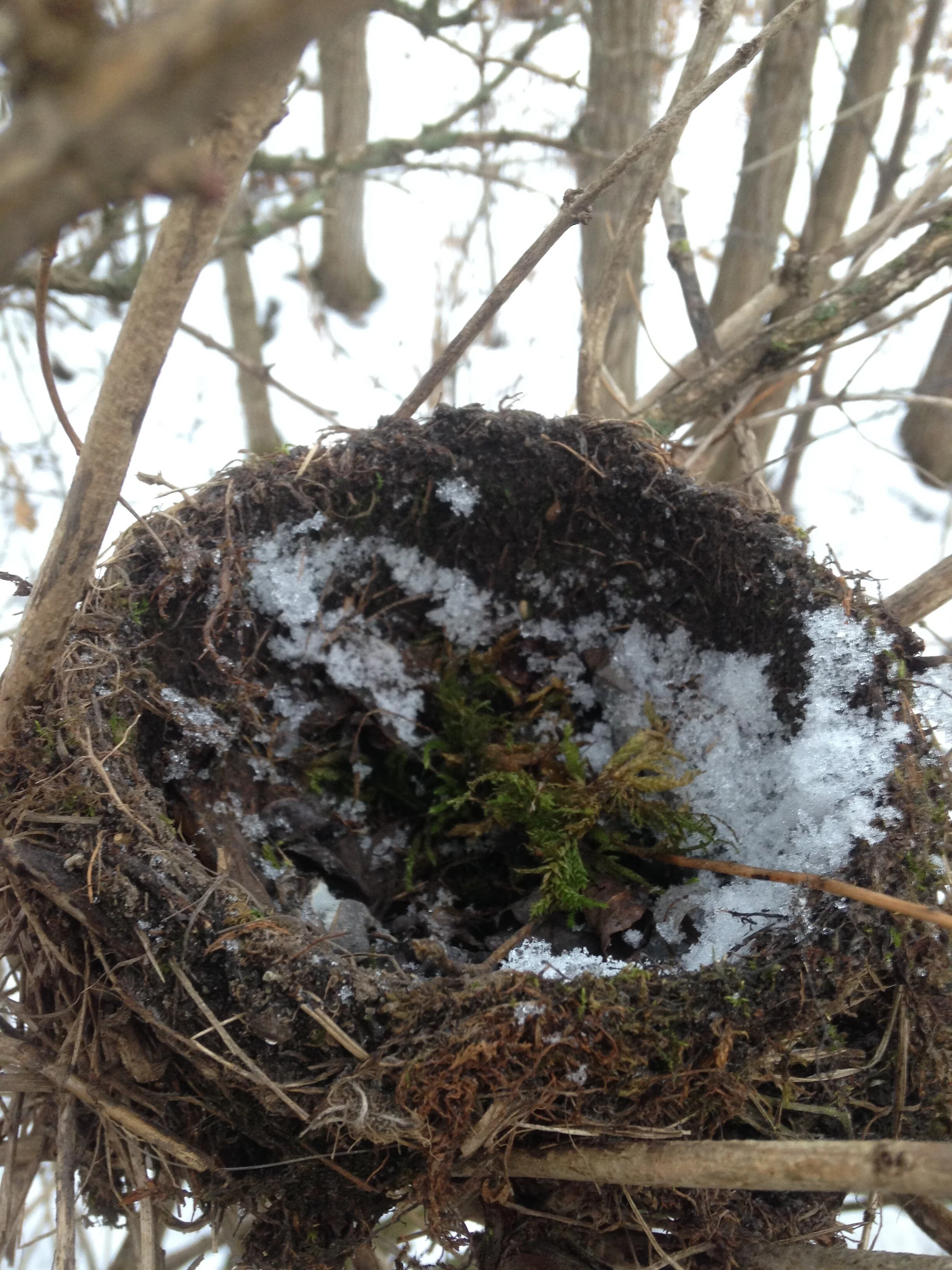
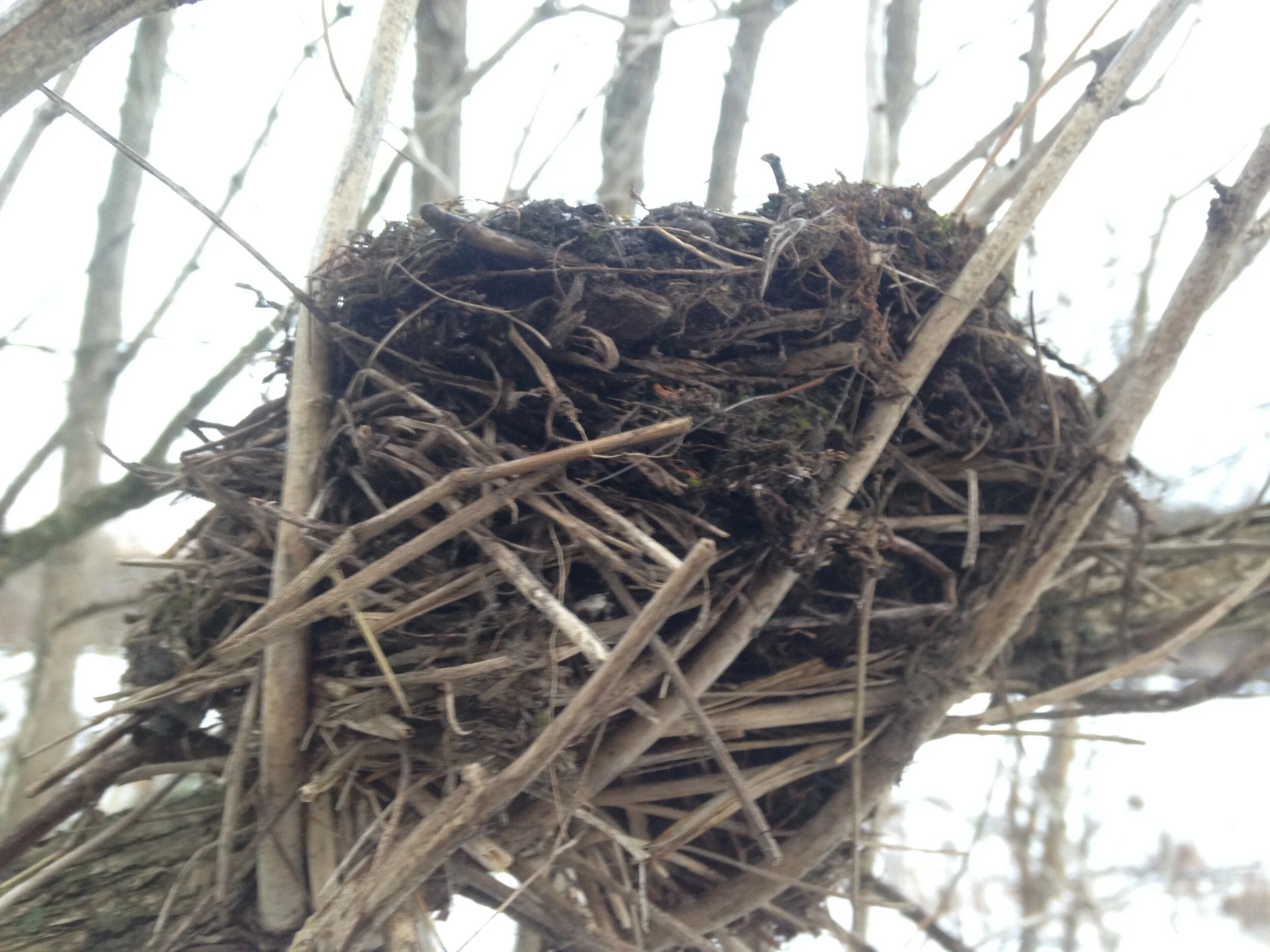
I am still learning what I should be measuring for, and looking for in general when trying to identify nests, but usually I look for these features:
Where is the nest: In a Honeysuckle shrub, about 168 cm (5’8”) off the ground, sitting on a main branch, midway out from the main trunk.
What is the nest made from: Small twigs on the outside, lined within with mud and a little moss.
How tall is the nest : 6.5-7 cm (depending on where you measure from)
Diameter of the top of the nest, from outside wall to outside wall: ??
How deep is the cup: 6 cm
Diameter of the cup: 10.5 cm
Other questions might be to consider when it was last used, any traces of feathers, shells, fur within the nest, but not used in construction, but which might point to who has been inhabiting the nest. Sometimes I also want to guess that the bird is a rare or unusual species, but I err on the side of common birds when uncertain between multiple species.
With all of this info, I am going to assume this is the nest of an American Robin.
I decided that it was time to keep moving. It wasn’t too cold, maybe -1, but I felt chilly from sitting in the snow writing my journal and taking notes. I followed the trail of the animal whose trail I had journaled about and noticed that they wandered down to the train tracks, and they seemed to hop on the tracks, leaving a bit of a tail drag in the process.
Trail and tail drag along the tracks.
The animal walked along the rail for about 6 m or so and then hopped off and headed down another trail towards the river. Here the Opossum meandered along a shared trail, and then headed for and was weaving between big Silver Maples (Acer saccharinum) growing right up close to the water. It seemed as if it was a bit of a searching trail, maybe looking for something to eat, or a place to sleep? Opossums tend to eat a lot of things including small Mammals, Birds, Insects, Reptiles, carrion, some plants, and garbage if they can access it. I have also learned that Opossums aren’t affected by the venom of Rattlesnakes found in North America, so they tend to prey on them when available. Opossums will also consume Shrews and Moles, where many other Mammals will not due to their bad taste.
This home or food searching led me on a long meandering wavy trail for most of the rest of the 3 hours I was trailing the animal. This was not a straight line like a Coyote or Squirrel trail but more like I remember a Skunk trail, veering left, and then sharp right, and then back tracking a meter and then on again in the general direction they were headed. I could predict which way the general trail was headed but it might have been because the area we were in, where the Opossum was wandering was bounded by a trail heavily used by Dog walkers and runners to the South and the Eramosa River to the North. This prediction was useful in that occasionally I would come to areas of bare ground where the snow had been caught by the thick nest of branches of the Buckthorns (Rhamnus cathartica), or had already melted. At these bare spots, I would have to either look in the mud, if it was muddy enough for any sign to be left behind, or look for small traces in the few icy scraps of snow remaining. Sometimes I would just walk in a straight line towards the river, and if nothing found, a straight line towards the running trail and I usually ended up catching the Opossum trail again.
Opossum (Didelphis virginiana) trail crossing over Beaver (Castor canadensis) trails.
A cool thing that happened a couple of times when the trail of the Opossum was closer to the river was that they crossed over some Beaver (Castor canadensis) trails. I have been stopping by a site along my way to work for a couple of weeks now investigating some Beaver chews, and some small trails out from the river up to some Aspens (Populus tremuloides) and White Ashs (Fraxinus americana) but those trails have not been as robust or heavily used as the ones I found by following the Opossum. Here there were many back and forths of, what I assume to be a couple of Beavers, based on the varied sizes of the tracks (I should have stopped to measure them). I saw the Beavers a couple of time in the warmer months while canoeing along the river, but since it got cold, I have only seen their signs left behind. It is cool to see how much space they claim along the river, eating up the fast growing deciduous trees (the photo above was taken close to a Manitoba Maple (Acer negundo) which had been coppiced by the Beavers.
Opossum trail in the snow
I continued on the Opossum trail, all the while hoping to find something even more exciting, like a kill site, or a bed, or or scat, or the Opossum themselves, but in the end I just lost the trail as they made their way to the heavily tracked Human dominated Dog walking trail. I searched throughout the area a little longer, in hopes of coming to see some tracks where the Opossum crossed over the Human/Dog trail but to no luck.
I continued on and found other cool trails from other animals, but none was as exciting as getting to trail the Opossum for such a long time, and thereby learning a little more about them and their behaviours.
Opossums seem really cool and I would love to be able to follow them again, and hopefully find more signs of their lives in the future. I’ll try and take some photos and write about too.



